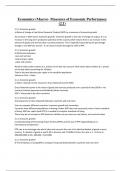Exam (elaborations)
Economics (Macro)- Measures of Economic Performance (2.1)
- Course
- Institution
Economics (Macro)- Measures of Economic Performance (2.1) 2.1.1 Economic growth a) Rates of change of real Gross Domestic Product (GDP) as a measure of economic growth An increase in GDP means economic growth. Economic growth is the rate of change of output. It is an increase in the long ...
[Show more]



